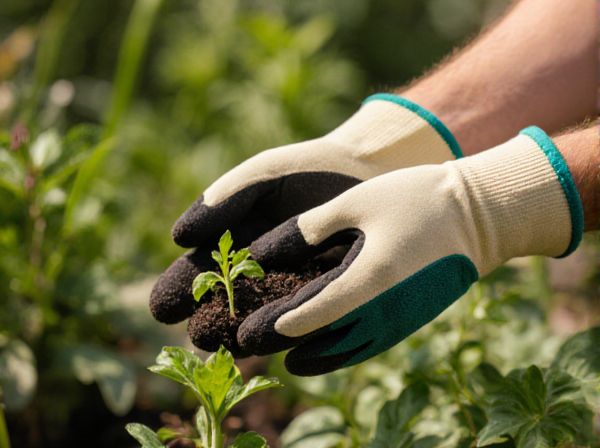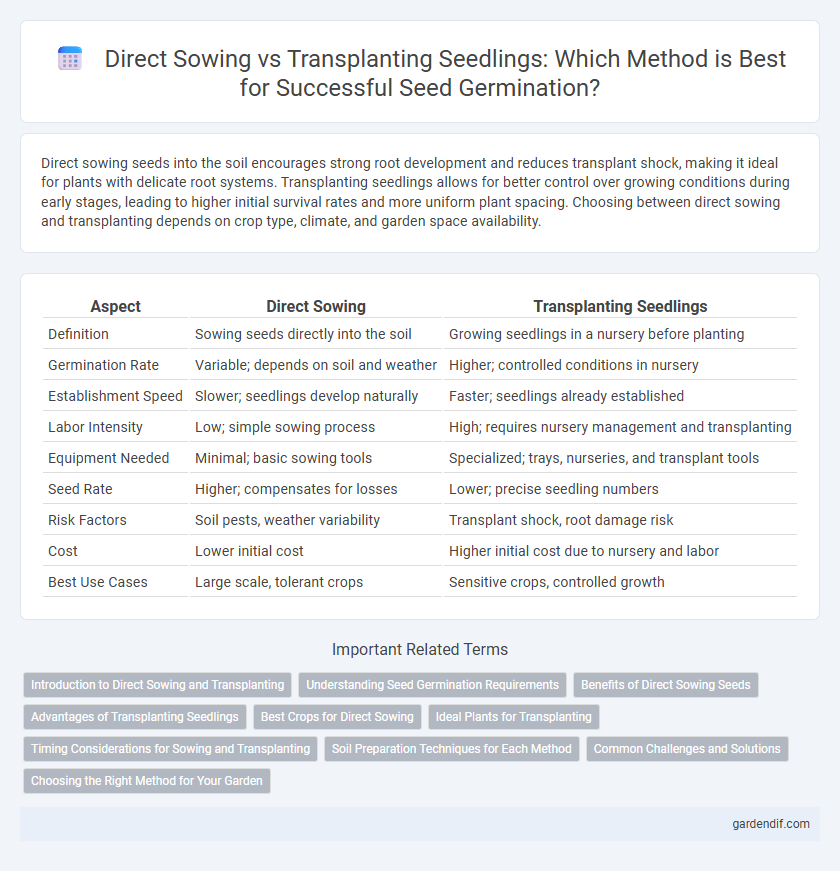
Direct sowing vs Transplanting seedlings Illustration
Direct sowing seeds into the soil encourages strong root development and reduces transplant shock, making it ideal for plants with delicate root systems. Transplanting seedlings allows for better control over growing conditions during early stages, leading to higher initial survival rates and more uniform plant spacing. Choosing between direct sowing and transplanting depends on crop type, climate, and garden space availability.
Table of Comparison
| Aspect | Direct Sowing | Transplanting Seedlings |
|---|---|---|
| Definition | Sowing seeds directly into the soil | Growing seedlings in a nursery before planting |
| Germination Rate | Variable; depends on soil and weather | Higher; controlled conditions in nursery |
| Establishment Speed | Slower; seedlings develop naturally | Faster; seedlings already established |
| Labor Intensity | Low; simple sowing process | High; requires nursery management and transplanting |
| Equipment Needed | Minimal; basic sowing tools | Specialized; trays, nurseries, and transplant tools |
| Seed Rate | Higher; compensates for losses | Lower; precise seedling numbers |
| Risk Factors | Soil pests, weather variability | Transplant shock, root damage risk |
| Cost | Lower initial cost | Higher initial cost due to nursery and labor |
| Best Use Cases | Large scale, tolerant crops | Sensitive crops, controlled growth |
Introduction to Direct Sowing and Transplanting
Direct sowing involves planting seeds directly into the soil where they will mature, promoting natural root development and reducing transplant shock. Transplanting seedlings allows for controlled early growth in nurseries, improving survival rates and enabling better spacing in the field. Choosing between these methods depends on crop type, climate conditions, and resource availability for optimal yield.
Understanding Seed Germination Requirements
Direct sowing requires seeds with high germination rates and tolerance to environmental conditions such as soil temperature, moisture, and light exposure, ensuring successful germination in situ. Transplanting seedlings allows control over germination conditions like temperature, humidity, and temperature, promoting uniform seedling development before exposure to outdoor stressors. Understanding species-specific seed dormancy and pre-germination treatments such as scarification or stratification enhances germination success in both direct sowing and transplanting methods.
Benefits of Direct Sowing Seeds
Direct sowing seeds promotes stronger root development by allowing plants to grow naturally in their final location, enhancing drought resistance and nutrient uptake. This method reduces transplant shock, leading to faster growth and higher survival rates in crops like corn, beans, and carrots. Direct sowing also minimizes labor and costs associated with nursery care, making it ideal for large-scale farming and home gardeners seeking efficient seed propagation.
Advantages of Transplanting Seedlings
Transplanting seedlings enhances early plant establishment by providing controlled growing conditions that increase survival rates and promote vigorous root development. This method allows for better spacing, reducing competition for nutrients and maximizing yield potential. Seedlings grown in nurseries are less vulnerable to pests and environmental stress, resulting in stronger, healthier plants.
Best Crops for Direct Sowing
Carrots, radishes, lettuce, and beans thrive with direct sowing due to their root systems and growth habits that avoid transplant shock. Corn and peas also perform well when sown directly, benefiting from immediate soil contact for rapid germination. These crops generally require less early-care stage care, making direct sowing an efficient method for fast-growing vegetables.
Ideal Plants for Transplanting
Plants with longer growing seasons, such as tomatoes, peppers, and eggplants, are ideal candidates for transplanting because starting them indoors extends their growth period. Transplanting ensures stronger seedlings can establish quickly, improving yields and reducing vulnerability to pests and weather fluctuations. Root vegetables and plants with delicate roots generally perform better with direct sowing rather than transplanting.
Timing Considerations for Sowing and Transplanting
Direct sowing seeds allows planting at the optimal soil temperature for germination, usually in late spring, reducing root disturbance and transplant shock. Transplanting seedlings should be timed after the last frost date and when seedlings have developed strong roots, typically 4-6 weeks after sowing indoors. Proper timing ensures higher survival rates and robust plant establishment in both methods.
Soil Preparation Techniques for Each Method
Direct sowing requires loose, well-drained soil that is finely tilled to ensure proper seed-to-soil contact and moisture retention, promoting uniform germination. Transplanting seedlings benefits from enriched, nutrient-dense soil amended with organic compost to support root establishment and reduce transplant shock. Both methods demand soil pH adjustments--generally between 6.0 and 7.0--optimized for the specific crop to enhance nutrient availability and growth.
Common Challenges and Solutions
Direct sowing often faces challenges like uneven germination and soil pests, which can be mitigated by using high-quality seeds and seed treatments. Transplanting seedlings struggles with root disturbance and transplant shock; solutions include hardening off seedlings prior to transplanting and using gentle handling techniques. Both methods benefit from proper soil preparation and consistent moisture management to enhance seedling establishment and growth.
Choosing the Right Method for Your Garden
Direct sowing places seeds directly into the soil, ensuring natural root development and reducing transplant shock, ideal for crops like carrots, beans, and peas. Transplanting seedlings involves starting seeds indoors or in controlled environments, allowing early growth and protection from pests, which suits tomatoes, peppers, and eggplants. Selecting the right method depends on your climate, growing season length, and crop type to optimize plant health and yield.
Direct sowing vs Transplanting seedlings Infographic

 gardendif.com
gardendif.com